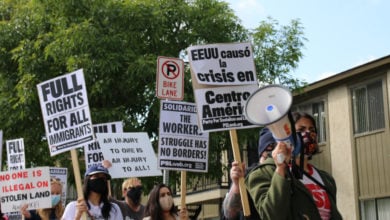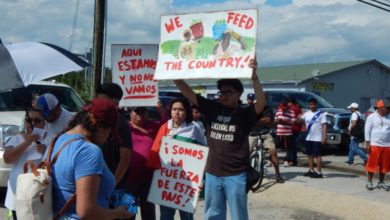Featured image: A photo of the wreckage from May 2. Credit: City of San Diego Fire-Rescue Twitter (@SDFD)
At least four people have died and over two dozen more hospitalized after a 40-foot vessel carrying approximately 30 migrants capsized off the coast of San Diego May 2. The boat broke apart after hitting rocks near Point Loma, which is a peninsula dividing San Diego Bay and the Pacific Ocean.
A “search and rescue” operation followed, with several survivors being arrested by U.S. immigration forces. The search for additional passengers continued into the night.
This comes days after hundreds of migrants were relocated from the U.S.-Mexico border to temporary facilities in Long Beach and Pomona, California. Thousands of people have been making their way to the United States as a result of the economic crisis that has been exacerbated by austerity measures and the ongoing COVID-19 pandemic.
The treacherous journey
Rather than provide basic necessities for those fleeing U.S.-backed terrorism in their communities, U.S. immigration policies deliberately endanger migrants in hopes that it will deter them from seeking to enter the U.S.. For example, Operation Gatekeeper, initiated in 1994, dumped $800 million into expanding the repressive apparatus at the U.S.-Mexico border over the next three years alone. As Liberation News points out: “These efforts to further militarize the U.S-Mexico border led to an increase in migrant deaths. According to U.S. Customs and Border Protection, 7,216 people died crossing the U.S.–Mexico border between 1998 and 2017. Over 5,500 other people are thought to be missing.”
The U.S. government has dumped billions of dollars into this terrorism in hopes it will serve as a deterrent. That has not worked. People continue to migrate to the U.S. often because the conditions in their communities have become more dangerous than the perilous journey to the north. U.S. immigration policy is not only inhumane, it is an abject failure with regard to its stated purpose. That money could have and should be spent on providing for everyone’s needs, regardless of immigration status.
A consequence of US imperialism
Though at this time the countries of origin of those on the vessel on May 2 remain unclear, one thing is certain: U.S. imperialism is the culprit. Between policies like Operation Gatekeeper and the nearly 60 interventions in Latin America alone, it is no surprise that the violence and dire economic conditions imposed by U.S.-backed dictatorships of capital is what causes people to follow the wealth that is being stolen from their homelands. This is something both major U.S. political parties refuse to acknowledge.
Just last week while addressing Guatemalan President Alejandro Giamettei, Kamala Harris claimed that the root causes of migration from Guatemala are “poverty and the lack, therefore, of economic opportunities; the issue of extreme weather conditions and the lack of climate adaptation; as well as corruption and the lack of good governance; and violence against women, Indigenous people, LGBTQ people, and Afro-descendants.”
What Harris failed to mention is that those conditions are being imposed upon the Guatemalan people by the United States! It has been supporting right-wing administrations like Giamettei’s and other reactionary movements in Guatemala since as early as the 1950s. The Biden-Harris administration’s response, rather than cutting funding to Giamettei’s regime or rescinding their support, is to allocate $310 million to fund the further militarization of Central American security forces.
Organizations such as the Committee in Solidarity with the People of El Salvador oppose the funding increase. CISPES argues it will only further fuel the violence and terror being imposed upon the people of Central America, making the crisis even worse.
Brief history of US-backed terrorism in Central America
One major act of U.S. intervention in Latin America was the June 1954 coup d’état led by Carlos Castillo Armas in response to the rise of a progressive government in Guatemala. This led to the breakout of a civil war in 1960 between anti-imperialist forces and CIA-backed counterrevolutionary mercenaries.
During the civil war, the U.S. committed genocide against indigenous Maya people, who overwhelmingly supported the revolutionary anti-colonial forces. At least 33,000 Mayan civilians and at least 10,000 others were slaughtered by counterrevolutionary forces. In total, over 200,000 Guatemalans died as a result of the war.
Many people in the United States are already aware of other instances of intervention, such as the “Iran-Contra scandal” under Ronald Reagan’s administration, where weapons were sold to Iran in order to fund U.S.-trained death squads in their crusade against the Nicaraguan Sandinista National Liberation Front. After a bloody struggle and fraudulent elections, U.S.-backed counterrevolutionaries came to power for 17 years until the FSLN won elections in 2006. The party has been reelected each time since. As recently as 2018, the U.S. has carried out major plots in an attempt to overthrow the Sandinista government, a major ally of Venezuela and Cuba.
Other examples include the 2009 coup in Honduras under the Obama-Biden administration which overthrew democratically elected President Manuel Zelaya. The chaos and terror that has persisted there ever since is an example of what a “successful” U.S.-regime change operation in Latin America looks like. And there is Haiti, which endured a 19-year U.S. colonial military occupation and had every popularly elected government overthrown by the U.S. since.
We must keep the ongoing role of U.S. intervention in Latin America and elsewhere in mind when we analyze events like the tragedy of May 2 if we hope to not only understand why they happen but how we can put an end to them. The struggle against capitalist imperialism and for internationalist socialism is key for the liberation of migrants and all oppressed people.




